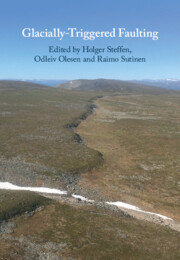Book contents
- Glacially-Triggered Faulting
- Glacially-Triggered Faulting
- Copyright page
- Contents
- Figures
- Tables
- Contributors
- Preface
- Part I Introduction
- Part II Methods and Techniques for Fault Identification and Dating
- Part III Glacially Triggered Faulting in the Fennoscandian Shield
- Part IV Glacially Triggered Faulting at the Edge and in the Periphery of the Fennoscandian Shield
- Part V Glacially Triggered Faulting Outside Europe
- 19 The Search for Glacially Induced Faults in Eastern Canada
- 20 Glacially Induced Faulting in Alaska
- 21 Indications on Glacially Triggered Faulting in Polar Areas
- Part VI Modelling of Glacially Induced Faults and Stress
- Part VII Outlook
- Index
- References
20 - Glacially Induced Faulting in Alaska
from Part V - Glacially Triggered Faulting Outside Europe
Published online by Cambridge University Press: 02 December 2021
- Glacially-Triggered Faulting
- Glacially-Triggered Faulting
- Copyright page
- Contents
- Figures
- Tables
- Contributors
- Preface
- Part I Introduction
- Part II Methods and Techniques for Fault Identification and Dating
- Part III Glacially Triggered Faulting in the Fennoscandian Shield
- Part IV Glacially Triggered Faulting at the Edge and in the Periphery of the Fennoscandian Shield
- Part V Glacially Triggered Faulting Outside Europe
- 19 The Search for Glacially Induced Faults in Eastern Canada
- 20 Glacially Induced Faulting in Alaska
- 21 Indications on Glacially Triggered Faulting in Polar Areas
- Part VI Modelling of Glacially Induced Faults and Stress
- Part VII Outlook
- Index
- References
Summary
Southern Alaska provides an ideal setting to assess how surface mass changes can influence crustal deformation and seismicity amidst rapid tectonic deformation. Since the end of the Little Ice Age, the glaciers of southern Alaska have undergone extensive wastage, retreating by kilometres and thinning by hundreds of metres. Superimposed on this are seasonal mass fluctuations due to snow accumulation and rainfall of up to metres of equivalent water height in fall and winter, followed by melting of gigatons of snow and ice in spring and summer and changes in permafrost. These processes produce stress changes in the solid Earth that modulate seismicity and promote failure on upper-crustal faults. Here we quantify and review these effects and how they combine with tectonic loading to influence faulting in the southeast, St. Elias and southwest regions of mainland Alaska.
Keywords
- Type
- Chapter
- Information
- Glacially-Triggered Faulting , pp. 353 - 365Publisher: Cambridge University PressPrint publication year: 2021
References
- 2
- Cited by



